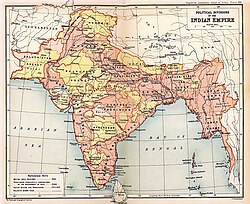British colonial rule on the Indian subcontinent (1858–1947) From Wikipedia, the free encyclopedia
The British Raj was a colony of the British Empire from 1858 to 1947 in South Asia. Raj is a word in Sanskrit that means "rule" and so "British Raj" means rule of the British Empire. The area of the colony is now in India, Pakistan, Bangladesh, Sri Lanka and Myanmar. The British Raj is also called British India.[3][4]
British Raj | |||||||||||||
|---|---|---|---|---|---|---|---|---|---|---|---|---|---|
| 1858–1947 | |||||||||||||
| Anthem: "God Save the King/Queen" [1] | |||||||||||||
 1909 Map of the British Indian Empire, showing British India in two shades of pink and the princely states in yellow. | |||||||||||||
| Status | Imperial political structure (British India, a quasi-federation of presidencies and provinces directly governed by the British Crown through the Viceroy and Governor-General of India, Princely States, governed by Indian rulers, under the suzerainty of The British Crown exercised through the Viceroy of India)[2] | ||||||||||||
| Capital | Calcutta (1858–1911) New Delhi (1911–1947) | ||||||||||||
| Common languages | |||||||||||||
| Religion | Hinduism, Islam, Christianity, Sikhism, Buddhism, Jainism, Zoroastrianism, Judaism | ||||||||||||
| Government | British Colonial Government | ||||||||||||
| Monarch of the United Kingdom and Emperor/Empressa | |||||||||||||
• 1858–1901 | Victoria | ||||||||||||
• 1901–1910 | Edward VII | ||||||||||||
• 1910–1936 | George V | ||||||||||||
• 1936 | Edward VIII | ||||||||||||
• 1936–1947 | George VI | ||||||||||||
| Viceroyb | |||||||||||||
• 1858–1862 | The 2nd Viscount Canning (first) | ||||||||||||
• 1947 | The 1st Viscount Mountbatten (last) | ||||||||||||
| Secretary of State | |||||||||||||
• 1858–1859 | Lord Stanley (first) | ||||||||||||
• 1947 | The 5th Earl of Listowel (last) | ||||||||||||
| Legislature | Imperial Legislative Council | ||||||||||||
| History | |||||||||||||
| 23 June 1757 & 10 May 1857 | |||||||||||||
| 2 August 1858 | |||||||||||||
| 18 July 1947 | |||||||||||||
| 14 and 15 August 1947 | |||||||||||||
| Currency | Indian rupee | ||||||||||||
| ISO 3166 code | IN | ||||||||||||
| |||||||||||||
| |||||||||||||
The term British Raj is used for the direct British rule over areas that had been conquered by the British in South Asia, It also included the independent princely states. These areas were governed by their own traditional rulers although they were under the overall authority of the British crown. An estimated 165 million people may have died as a result of British colonial policies from 1880 to 1920. This number is larger than the death toll from both World War I and World War II, including The Holocaust.[5][6]
Myanmar or Burma became its own British colony in 1937. The colony of Aden came under the same government from 1858 to 1937, as were British Somaliland (now part of Somalia) from 1884 to 1898 and Singapore from 1858 to 1867.
British rule ended on 15 August 1947. The borders between India and Pakistan came into effect on the 18 August. Many people died during the Partition of India.
Jammu and Kashmir, like the other princely states, had not been under direct British rule. India and Pakistan went to war over the area, which is now divided between them.
The 1861 census showed that the British population in the subcontinent was 125,945. Only 41,862 of them were civilians as compared with 84,083 European officers and men of the Army.[7] In 1880, the standing Indian Army consisted of 66,000 British soldiers, 130,000 natives, and 350,000 soldiers in the princely armies.[8]
Seamless Wikipedia browsing. On steroids.
Every time you click a link to Wikipedia, Wiktionary or Wikiquote in your browser's search results, it will show the modern Wikiwand interface.
Wikiwand extension is a five stars, simple, with minimum permission required to keep your browsing private, safe and transparent.